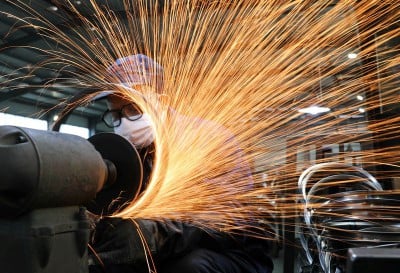 © Reuters. A worker wearing a face mask works on a production line manufacturing bicycle steel rim at a factory, as the country is hit by the novel coronavirus outbreak, in Hangzhou, Zhejiang province, China March 2, 2020. China Daily via REUTERS/File Photo HK50 -1.79% Add to/Remove from Watchlist Add to Watchlist Add Position
© Reuters. A worker wearing a face mask works on a production line manufacturing bicycle steel rim at a factory, as the country is hit by the novel coronavirus outbreak, in Hangzhou, Zhejiang province, China March 2, 2020. China Daily via REUTERS/File Photo HK50 -1.79% Add to/Remove from Watchlist Add to Watchlist Add Position Position added successfully to:
+ Add another position Close SCBFF -0.13% Add to/Remove from Watchlist Add to Watchlist Add Position
Position added successfully to:
+ Add another position Close USD/CNH +0.12% Add to/Remove from Watchlist Add to Watchlist Add Position
Position added successfully to:
+ Add another position Close
By Joe Cash
BEIJING (Reuters) - China's manufacturing activity unexpectedly contracted in October, underlining the daunting task facing policymakers as they try to revitalise economic growth heading into the end of the year and 2024 amid multiple challenges at home and abroad.
Recent indicators pointed to encouraging signs of stabilising in the world's second-largest economy, supported by a flurry of policy support measures, although a protracted property crisis and soft global demand remain major headwinds.
The official purchasing managers' index (PMI) fell to 49.5 in October from 50.2, dipping back below the 50-point level demarcating contraction from expansion, data from the National Bureau of Statistics showed on Tuesday. It missed a forecast of 50.2 and was worse than the most pessimistic prediction of 49.9 by Standard Chartered (OTC:SCBFF) in a Reuters poll.
The non-manufacturing PMI also fell to 50.6 last from 51.7 in September, indicating a slowdown in activity in the vast service sector and construction.
"The weak PMI data may reflect some of the weakness in demand related to the housing slump and a slowdown in infrastructure spending," said Xu Tianchen, senior economist at the Economist Intelligence Unit.
"Although there are signs of exports bottoming out, a strong recovery in external demand is probably elusive," he added.
Both new export and imports orders shrank for an eight consecutive month, suggesting that manufacturers were struggling for buyers overseas and ordering fewer components used in finished goods for re-export.
Foreign buyers returned in force for the autumn round of the Canton Fair in Guangzhou, the world's largest trade show, but Chinese sellers said orders remain low as Christmas nears, with few expecting global demand to recover soon.
"Given that PMI is a month-on-month indicator, the falling figure in October doesn't reflect much of a change in demand but an adjustment in supply," said Dan Wang, chief economist at Hang Seng Bank China.
"Production in September was visibly better than in previous months due to improved domestic demand, which squeezed down industrial prices. In October, we saw a wider effort in the industrial sector to cut supply to cope with a profit squeeze."
The squeeze on business profits was underscored by factory gate prices contracting sharply this month, a sub-index in the PMI survey showed.
Prices of most nonferrous metals fell following the data release. China accounts for more than half of the global consumption of most base metals, which are widely used in the manufacturing sector.
In the currency market, the offshore yuan dropped after the PMI survey.
MORE SUPPORT NEEDED
Policymakers have since June unveiled a raft of measures after a rapid loss of economic momentum following a brief post-COVID rebound, including modest interest rate cuts, increased cash injections and more aggressive fiscal stimulus.
But analysts say more policy support may be needed to ensure the economy reaches Beijing's annual gross domestic product (GDP) target of about 5%.
Some government advisers are recommending China lifts its 2024 budget deficit target beyond the 3% of GDP set for this year, which would allow Beijing to issue more bonds to revive the economy.
HSBC on Monday said it believed the worst may be over for China's shaky commercial real estate market, as a further $500 million charge from the sector dragged the bank's third quarter profits below forecasts.
Yet, the overall real estate industry, which accounts for almost a fourth of the country's economic output, has shown few signs of turning a decisive corner since plunging into debt crisis two years ago.
Data out this month showed China's new home prices fell for a third straight month in September, a traditionally peak home buying period, while property sales and investment extended double-digit declines. High youth unemployment, elevated debt levels and a weakened yuan are also complicating Beijing's efforts to revive activity.
China's top parliamentary body last week approved a 1 trillion yuan ($137 billion) sovereign bond issue in the fourth quarter, and passed a bill allowing local governments to front load part of their 2024 bond quotas to support investment and economic growth.
And earlier this month, the central bank injected the biggest cash support since late 2020 via short-term policy loans to allow banks to extend credit as well as keep interest rates low.
"The additional 1 trillion yuan will help in November and December," Economist Intelligence Unit's Xu said.
China factory activity unexpectedly shrinks in Oct, dents recovery momentum 1 Recommended

Barry Callebaut adjusts growth targets based on new strategy

Airbnb turns to AI to help prevent house parties

US-China chip war: Beijing unhappy at latest wave of US restrictions

What is an interest rate

Student Loans Without Paying
